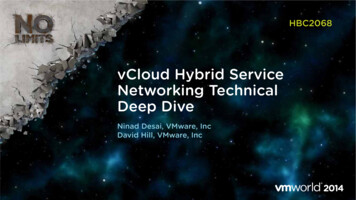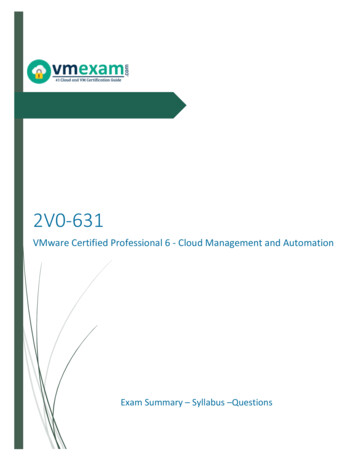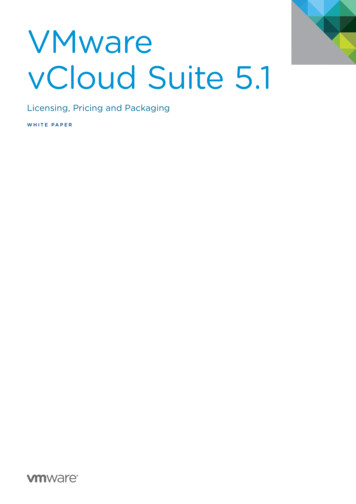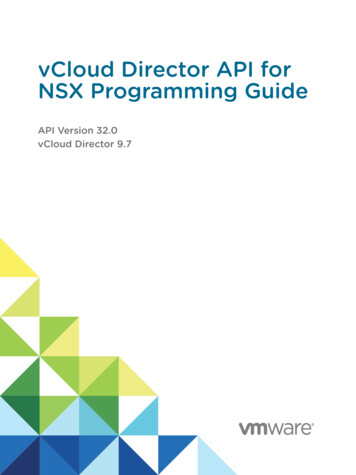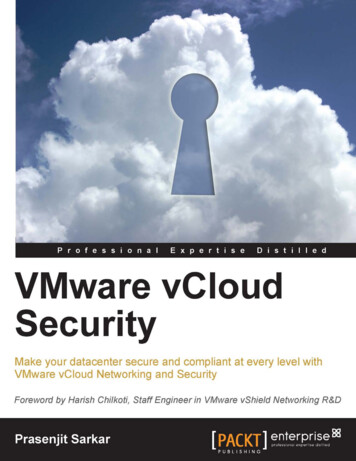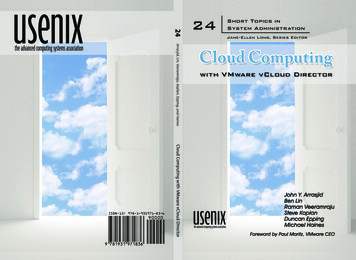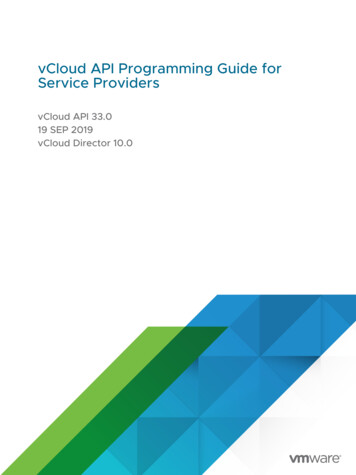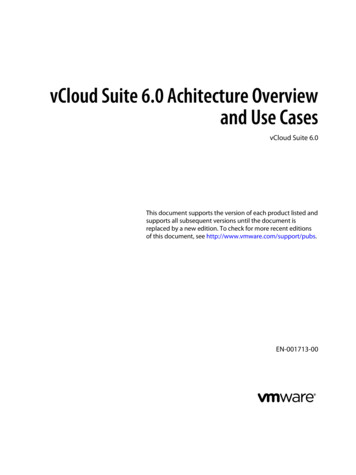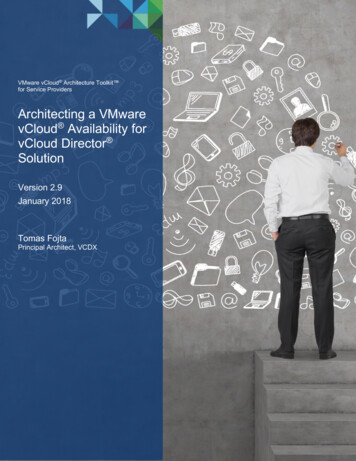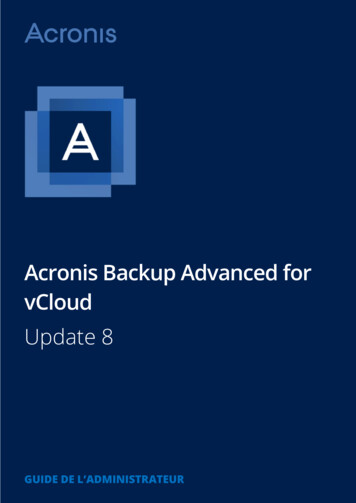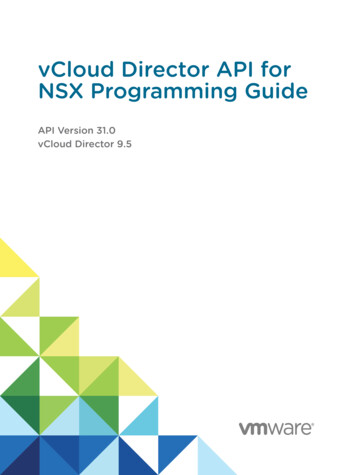
Transcription
vCloud Director API forNSX Programming GuideAPI Version 31.0vCloud Director 9.5
vCloud Director API for NSX Programming GuideYou can find the most up-to-date technical documentation on the VMware website at:https://docs.vmware.com/If you have comments about this documentation, submit your feedback todocfeedback@vmware.comVMware, Inc.3401 Hillview Ave.Palo Alto, CA 94304www.vmware.comCopyright 2016, 2018 VMware, Inc. All rights reserved. Copyright and trademark information.VMware, Inc.2
Contents1 About the vCloud Director API for NSX 4Updated Information72 NSX Edge Gateway Management 8Query or Upgrade an Edge GatewayEdge DHCP Services9Edge Firewall ServicesEdge NAT Services81011Edge Routing Services12Edge Load Balancer ServicesEdge SSL VPN ServicesEdge L2 VPN Services141721Edge IPSec VPN Services21Edge Interfaces, Logging, Statistics, and Remote Access Properties223 NSX Distributed Firewall Service 244 NSX Services 28Certificate Management28Applications and Application GroupsSecurity GroupsSecurity Tags3031Grouping ObjectsVMware, Inc.30323
1About the vCloud Director APIfor NSXThe vCloud Director API for NSX is a proxy API that enables vCloud API clients to make requests to theNSX API.Use this document as a supplement to the NSX vSphere API Guide (NSX version 6.2 or later). Thisdocument lists the subset of NSX API requests supported by the vCloud Director API for NSX andprovides information about differences between those requests as they are described in the NSX APIdocumentation and how you must make them when using the vCloud Director API for NSX.Relationship to the NSX APIThe vCloud Director API for NSX supports a subset of the operations and objects defined in the NSXvSphere API Guide. The API supports NSX 6.2, 6.3, and 6.4. You can download the NSX vSphere APIGuide from base/PDF/nsx 62 api.pdf (NSX re.ICbase/PDF/nsx 63 api.pdf (NSX 6.3), e/6.4/nsx 64 api.pdf (NSX 6.4). Requests listed inthis document, along with related examples documented in the NSX vSphere API Guide, can be used bycallers of the vCloud Director API for NSX with a few modifications and some additional constraints.Relationship to the vCloud APIThe vCloud Director API for NSX is not part of the vCloud API. It uses a proxy facility to allow clients thathave authenticated to the vCloud API to make NSX API requests through the vCloud Director securepublic URL with a network suffix. Examples in this document represent this URL ashttps://vcloud.example.com/network.Note The cross-virtual data center networking feature is available via the vCloud OpenAPI. Forinformation about vCloud OpenAPI, see Getting Started with vCloud OpenAPI athttps://code.vmware.com.Multi-Tenant Support The NSX API is designed to address NSX objects in a global scope like that of a VMware vCenter datacenter. The NSX Proxy API is designed to address NSX objects within the scope of a vCloud Directortenant organization.VMware, Inc.4
vCloud Director API for NSX Programming GuideWhere the NSX API uses internal edge identifiers such as edge-1 (typically shown as edgeId in the NSXvSphere API Guide) to identify an edge, the vCloud Director API for NSX uses the identifier thatvCloud Director assigns to the edge. This is a unique identifier in the form of a UUID, as defined by RFC4122. Use of this identifier allows the API to restrict access to an edge to members of the organizationthat owns the edge. Organization members' access to an edge is also governed by their role in theorganization and the rights associated with that role. The vCloud Director API for NSX uses this edgeUUID only to identify the edge, locate the NSX Manager responsible for the edge, and retrieve its internalNSX edge id, which it uses in subsequent NSX API operations on the edge.Operations on other NSX objects such as certificates and grouping objects typically require avCloud Director organization or VDC UUID in the request to limit access to tenants with rights to thevCloud Director object.vCloud Director system administrators can view or update all edges in the system.SecurityHTTP communications between a vCloud API client and server are secured with SSL. API clients mustalso complete a login request to receive an authorization token that must be included in all subsequentrequests.Request HeadersThe following HTTP headers are typically included in requests:AcceptAll requests must include an HTTP Accept header that designates thevCloud Director API for NSX version that the client is using.Accept: application/* xml;version api-versionFor example, the following header indicates that the request is from avCloud Director API for NSX version 29.0 client.Accept: application/* xml;version 29.0Accept-EncodingBy default, the system returns response content as uncompressed XML.Compressing the response can improve performance, especially when theresponse is large and network bandwidth is a factor. (Requests cannot becompressed.) To request a response to be returned as compressed XML,include the following header:Accept-Encoding: gzipVMware, Inc.5
vCloud Director API for NSX Programming GuideThe response is encoded using gzip encoding as described in RFC 1952,and includes the following header:Content-Encoding: gzipIn the default configuration, responses smaller than 64KB are nevercompressed.Accept-LanguageMessage strings in ErrorType responses are localized. To specify thelanguage desired in responses, use the Accept-Language request header.To request a response with message strings localized to French, use thefollowing header:Accept-Language: frAuthorizationAll requests to create a vCloud API session must include anAuthorization header of the form prescribed by the identity provider thatyour organization uses. See the vCloud API Programming Guide forService Providers.Content-TypeRequests that include a body must include the following HTTP ContentType header.Content-type: application/xmlx-vcloud-authorizationThis header, which is returned with the Session response after asuccessful log-in, must be included in all subsequent requests from clientsthat authenticate to the integrated identity provider or the SAML identityprovider. See the vCloud API Programming Guide for Service Providers.X-VMWARE-VCLOUDCLIENT-REQUEST-IDThe value of this header is used to build a request ID returned in the valueof the X-VMWARE-VCLOUD-REQUEST-ID header. The value of thisheader cannot contain more than 128 characters drawn from the set ofletters, numbers, and the hyphen (-). Values with invalid characters areignored. Values with more than 128 characters are truncated.VMware, Inc.6
Updated InformationThis vCloud Director API for NSX Programming Guide is updated with each release of the product orwhen necessary.This table provides the update history of the vCloud Director API for NSX Programming Guide.RevisionDescription06 NOV 2018Added topic Grouping Objects to provide information about creating and managing IP address groups and MACaddress groups in an organization virtual data center.04 OCT 2018Initial release.VMware, Inc.7
2NSX Edge GatewayManagementEach NSX Edge Gateway provides network edge security and gateway services to isolate a virtualizednetwork.This chapter includes the following topics:nQuery or Upgrade an Edge GatewaynEdge DHCP ServicesnEdge Firewall ServicesnEdge NAT ServicesnEdge Routing ServicesnEdge Load Balancer ServicesnEdge SSL VPN ServicesnEdge L2 VPN ServicesnEdge IPSec VPN ServicesnEdge Interfaces, Logging, Statistics, and Remote Access PropertiesQuery or Upgrade an Edge GatewayYou can use the vCloud Director API for NSX to query all edges, query a specific edge, or upgrade anedge.nAPI-URL is a URL of the form https://vcloud.example.com/network.nid is a vCloud Director unique identifier in the form of a UUID, as defined by RFC 4122.n# is a small integer used in an NSX object identifier.Table 2‑1. Summary of NSX Edge Gateway Query and Upgrade RequestsOperationRequestRequest BodyResponseList all edges in the system.GET API-URL/edgesNonepagedEdgeListList the edge with identifier id.GET API-URL/edges/idNoneedgeGet the status of the edgewith identifier id.GET API-URL/edges/id /statusNoneedgeStatusVMware, Inc.8
vCloud Director API for NSX Programming GuideTable 2‑1. Summary of NSX Edge Gateway Query and Upgrade Requests (Continued)OperationRequestRequest BodyResponseGet the summary of the edgewith identifier id.GET API-URL/edges/id /summaryNoneedgeSummaryGet the list of all jobs for theedge with identifier id.GET API-URL/edges/id/jobsNoneedgeJobsGet the list of active jobs forthe edge with identifier id.GET API-URL/edges/id/jobs?status activeNoneedgeJobsUpgrade the edge withidentifier id.POST API-URL/edges/id /?action upgradeNone204 No ContentList the edges contained byvCloud Director organizationVDC with id id.GET API-URL/edges/?orgVdc idNoneedgeSummariesConfigure the edge withidentifier id to use NSX FIPSmode. Requires NSX 6.3 orlater.POST API-URL/edges/id /fips?enable [true false]None204 No ContentNote This option is availableonly if the systemadministrator has allowedenablement of FIPS mode onEdge Gateways. For moreinformation about FIPSmode, see FIPS Mode in theVMware NSX for vSpheredocumentation.Edge DHCP ServicesAn NSX edge gateway capabilities include IP address pooling, one-to-one static IP address allocation,and external DNS server configuration. Static IP address binding is based on the managed object ID andinterface ID of the requesting client virtual machine.The DHCP relay capability provided by NSX in your vCloud Director environment enables you to leverageyour existing DHCP infrastructure from within your vCloud Director environment without any interruptionto the IP address management in your existing DHCP infrastructure. DHCP messages are relayed fromvirtual machines to the designated DHCP servers in your physical DHCP infrastructure, which allows IPaddresses controlled by the NSX software to continue to be in synch with IP addresses in the rest of yourDHCP-controlled environments.NotenDHCP relay does not support overlapping IP address spaces.nDHCP relay and DHCP service cannot run on the same vNIC at the same time. If a relay agent isconfigured on a vNIC, a DHCP pool cannot be configured on the subnets of that vNIC. See the NSXAdministration Guide for details.VMware, Inc.9
vCloud Director API for NSX Programming GuideIn the table below:nAPI-URL is a URL of the form https://vcloud.example.com/network.nid is a vCloud Director unique identifier in the form of a UUID, as defined by RFC 4122.n# is a small integer used in an NSX object identifier.Table 2‑2. Summary of NSX Edge DHCP RequestsOperationRequestRequest BodyResponseRetrieve DHCP configurationfor the edge with identifier id.GET API-URL/edges/id/dhcp/configNonedhcpUpdate DHCP configurationfor the edge with identifier id.PUT API-URL/edges/id/dhcp/configdhcp204 No ContentReset DHCP configuration forthe edge with identifier id tofactory defaults.DELETE API-URL/edges/id/dhcp/configNone204 No ContentAppend an IP address pool tothe set of DHCP poolsconfigured for the edge withidentifier id.POST API-URL/edges/id/dhcp/config/ippoolsipPool204 No ContentDelete the IP address poolidentified by ippool-# fromDELETE API-URL/edges/id/config/ippools/ippool-#None204 No ContentRetrieve the DHCP relayconfiguration from the edgewith identifier id.GET API-URL/edges/id/dhcp/config/relayNonerelayUpdate the DHCP relayconfiguration for the edgewith identifier id.PUT API-URL/edges/id/dhcp/config/relayrelay204 No ContentReset DHCP relayconfiguration for the edgewith identifier id.to factorydefaults.DELETE API-URL/edges/id/dhcp/config/relayNone204 No ContentRetrieve DHCP leaseinformation from the edgewith identifier id.GET API-URL/edges/id/dhcp/leaseInfoNonedhcpLeasesthe edge with identifier id.Edge Firewall ServicesEdge Firewall provides perimeter security for organization VDC networks.nAPI-URL is a URL of the form https://vcloud.example.com/network.nid is a vCloud Director unique identifier in the form of a UUID, as defined by RFC 4122.n# is a small integer used in an NSX object identifier.VMware, Inc.10
vCloud Director API for NSX Programming GuideTable 2‑3. Summary of NSX Edge Firewall RequestsOperationRequestRequest BodyResponseRetrieve firewall configurationfor the edge with identifier id.GET API-URL/edges/id/firewall/configNonefirewallUpdate firewall configurationfor the edge with identifier id.PUT API-URL/edges/id/firewall/configfirewall204 No ContentReset firewall configurationfor the edge with identifier idto factory defaults.DELETE API-URL/edges/id/firewall/configNone204 No ContentAppend an edge firewall rulefor the edge with identifier id.POST s201 CreatedAdd an edge firewall rule forthe edge with identifier idabove the rule identified by #POST API-URL/edges/id/firewall/config/rules?aboveRuleId #firewallRules201 CreatedRetrieve the edge firewall ruleidentified by # . (Cannotretrieve internal rules or thedefault policy rule.)GET llRuleUpdate the edge firewall ruleidentified by # . (Cannotupdate internal rules or thedefault policy rule.)PUT allRule204 No ContentDelete the edge firewall ruleidentified by # . (Cannotdelete internal rules or thedefault policy rule.)Delete APIURL/edges/id/firewall/config/rules/#None204 No ContentRetrieve statistics for theedge firewall rule identified by# . (Cannot retrieve statisticsfor internal rules or the defaultpolicy rule.)GET dStatisticsEdge NAT ServicesNSX Edge provides network address translation (NAT) service to assign a public address to a computeror group of computers in a private network. Using this technology limits the number of public IPaddresses that an organization requires. You must configure NAT rules to provide access to servicesrunning on privately addressed virtual machines.nAPI-URL is a URL of the form https://vcloud.example.com/network.nid is a vCloud Director unique identifier in the form of a UUID, as defined by RFC 4122.n# is a small integer used in an NSX object identifier.VMware, Inc.11
vCloud Director API for NSX Programming GuideTable 2‑4. Summary of NSX Edge NAT RequestsOperationRequestRequest BodyResponseRetrieve edge NATconfiguration for the edgewith identifier id.GET API-URL/edges/id/nat/configNonenatUpdate edge NATconfiguration for the edgewith identifier id.PUT API-URL/edges/id/nat/confignat204 No ContentReset edge NATconfiguration for the edgewith identifier id to factorydefaults.DELETE API-URL/edges/id/nat/configNone204 No ContentAppend a NAT rule to NATPOST API-URL/edges/id/nat/config/rulesnatRules201 CreatedAdd an edge NAT rule abovethe rule with identifier# on theedge with identifier id.POST API-URL/edges/id/nat/config/rules/?aboveRuleId #natRule201 CreatedUpdate edge NAT rule withidentifier# on the edge withidentifier id.PUT API-URL/edges/id/nat/config/rules/#natRule204 No ContentDelete edge NAT rule withthe identifier# from the edgewith identifier id.Delete API-URL/edges/id/nat/config/rules/#None204 No Contentrules on the edge withidentifier id.Note Every external IP address associated with a NAT rule must be registered as a secondary addresson the Edge Gateway's uplink interface. The vCloud Director API for NSX handles this registrationautomatically. Administrators using the NSX API must register those external IP addresses manually.Edge Routing ServicesDynamic routing protocols such as OSPF and BGP provide forwarding information between layer 2broadcast domains.nAPI-URL is a URL of the form https://vcloud.example.com/network.nid is a vCloud Director unique identifier in the form of a UUID, as defined by RFC 4122.n# is a small integer used in an NSX object identifier.VMware, Inc.12
vCloud Director API for NSX Programming GuideTable 2‑5. Summary of NSX Edge Routing RequestsOperationRequestRequest BodyResponseRetrieve the routingconfiguration for the edgewith identifier idGET API-URL/edges/id/routing/configNoneroutingUpdate the routingconfiguration for the edgewith identifier idPUT API-URL/edges/id/routing/configrouting204 No ContentDelete the routingconfiguration for the edgewith identifier idDELETE API-URL/edges/id/routing/configNone204 No ContentRetrieve the global routingconfiguration for the edgeGET lobalConfigUpdate the global routingconfiguration for the edgewith identifier idPUT lConfig204 No ContentRetrieve the static routingconfiguration for the edgewith identifier idGET utingUpdate the static routingconfiguration for the edgewith identifier idPUT g204 No ContentDelete static and defaultrouting configuration for theedge with identifier idDELETE API-URL/edges/id/routing/config/staticNone204 No ContentRetrieve the OSPF routingconfiguration for the edgewith identifier idGET API-URL/edges/id/routing/config/ospfNoneospfUpdate the OSPF routingconfiguration for the edgewith identifier idPUT API-URL/edges/id/routing/config/ospfospf204 No ContentDelete OSPF routingconfiguration for the edgewith identifier idDELETE API-URL/edges/id/routing/config/ospfNone204 No ContentRetrieve the BGP routingconfiguration for the edgewith identifier idGET API-URL/edges/id/routing/config/bgpNonebgpUpdate the BGP routingconfiguration for the edgewith identifier idPUT API-URL/edges/id/routing/config/bgpbgp204 No ContentDelete BGP routingconfiguration for the edgewith identifier idDELETE API-URL/edges/id/routing/config/bgpNone204 No Contentwith identifier idVMware, Inc.13
vCloud Director API for NSX Programming GuideEdge Load Balancer ServicesThe NSX Edge load balancer distributes incoming service requests evenly among multiple servers insuch a way that the load distribution is transparent to users. Load balancing thus helps in achievingoptimal resource utilization, maximizing throughput, minimizing response time, and avoiding overload.NSX Edge provides load balancing up to Layer 7.nAPI-URL is a URL of the form https://vcloud.example.com/network.nid is a vCloud Director unique identifier in the form of a UUID, as defined by RFC 4122.n# is a small integer used in an NSX object identifier.Table 2‑6. Summary of NSX Edge Load Balancer RequestsOperationRequestRequest BodyResponseRetrieve the load balancerconfiguration for the edgewith identifier id.GET erUpdate the load balancerconfiguration for the edgewith identifier id.PUT 4 No ContentDelete the load balancerconfiguration for the edgewith identifier id.DELETE API-URL/edges/id/loadbalancer/configNone204 No ContentRetrieve the load balancervirtual server configuration forthe edge with identifier id.GET NoneloadBalancerUpdate the load balancervirtual server configuration forthe edge with identifier id. byappending the virtual serverdefined in the request body.POST virtualServer201 CreatedDelete the load balancervirtual server configuration forthe edge with identifier id.DELETE None204 No ContentRetrieve the configuration ofthe load balancer virtualserver with identifiervirtualServer-# for theGET /virtualServer-#NonevirtualServerPUT /virtualServer-#virtualServer204 No Contentedge with identifier id.Update the configuration ofthe load balancer virtualserver with identifiervirtualServer-# for theedge with identifier id.VMware, Inc.14
vCloud Director API for NSX Programming GuideTable 2‑6. Summary of NSX Edge Load Balancer Requests (Continued)OperationRequestRequest BodyResponseDelete the configuration ofthe load balancer virtualserver with identifiervirtualServer-# for theDELETE /virtualServer-#None204 No ContentRetrieve the load balancerpool configuration for theedge with identifier idGET BalancerUpdate the load balancerpool configuration for theedge with identifier id byappending the pool defined inthe request body.POST APIURL/edges/id/loadbalancer/config/poolspool201 CreatedDelete the load balancer poolconfiguration for the edgewith identifier idDELETE APIURL/edges/id/loadbalancer/config/poolsNone204 No ContentRetrieve the load balancerpool with id pool-# for theGET nepoolPUT ol204 No ContentDELETE ne204 No ContentRetrieve the load balancerapplication profileconfiguration for the edgewith identifier idGET filesNoneloadBalancerUpdate the load balancerapplication profileconfiguration for the edgewith identifier id to append theapplication profile defined inthe request body.POST filesapplicationProfile201 CreatedDelete the load balancerapplication profileconfiguration for the edgewith identifier idDELETE filesNone204 No ContentRetrieve the load balancerapplication profile with idapplicationProfile-# forGET ge with identifier id.edge with identifier idUpdate the load balancerpool with id pool-# for theedge with identifier idDelete the load balancer poolwith id pool-# for the edgewith identifier idthe edge with identifier idVMware, Inc.15
vCloud Director API for NSX Programming GuideTable 2‑6. Summary of NSX Edge Load Balancer Requests (Continued)OperationRequestRequest BodyResponseUpdate the load balancerapplication profile with id forthe edge with identifierapplicationProfile-# idPUT files/applicationProfile-#applicationProfile204 No ContentDelete the load balancerapplication profile with idapplicationProfile-# forDELETE files/applicationProfile-#None204 No ContentRetrieve the load balancerapplication rule configurationfor the edge with identifier idGET esNoneloadBalancerUpdate the load balancerapplication rule configurationfor the edge with identifier idto append the application ruledefined in the request body.POST esapplicationRule201 CreatedDelete the load balancerapplication rule configurationfor the edge with identifier idDELETE esNone204 No ContentRetrieve the load balancerapplication rule with idapplicationRule-# for theGET es/applicationRule-#NoneapplicationRulePUT es/applicationRule-#applicationRule204 No ContentDELETE es/applicationRule-#None204 No ContentRetrieve the load balancermonitor configuration for theedge with identifier id.GET adBalancerUpdate the load balancermonitor configuration for theedge with identifier id toappend the monitor defined inthe request body.POST r201 CreatedDelete the load balancermonitor configuration for theedge with identifier id.DELETE 4 No ContentRetrieve the load balancermonitor with id monitor-# forGET or-#Nonemonitorthe edge with identifier idedge with identifier idUpdate the load balancerapplication rule with idapplicationRule-# for theedge with identifier idDelete the load balancerapplication rule with idapplicationRule-# for theedge with identifier id.the edge with identifier id.VMware, Inc.16
vCloud Director API for NSX Programming GuideTable 2‑6. Summary of NSX Edge Load Balancer Requests (Continued)OperationRequestRequest BodyResponseUpdate the load balancermonitor with id monitor-# forPUT or-#monitor204 No ContentDELETE or-#None204 No ContentRetrieve load balancer statusand statistics for the edgewith identifier id.GET lancerStatusAndStatsEnable load balancer poolmember identified bymember- # on the edge withPOST -#?enable trueNone204 No Contentthe edge with identifier id.Delete the load balancermonitor with id monitor-# forthe edge with identifier id.identifier id.Edge SSL VPN ServicesNSX Edge SSL VPN services enable remote users to connect securely to private networks behind anEdge Gateway.nAPI-URL is a URL of the form https://vcloud.example.com/network.nid is a vCloud Director unique identifier in the form of a UUID, as defined by RFC 4122.n# is a small integer used in an NSX object identifier.Table 2‑7. Summary of NSX Edge SSL VPN RequestsOperationRequestRequest BodyResponseRetrieve the SSL VPNconfiguration for the edge withidentifier id.GET te the SSL VPNconfiguration for the edge withidentifier id.PUT API-URL/edges/id/sslvpn/configsslvpnConfig204 No ContentEnable or disable the SSL VPNconfiguration for the edge withidentifier id.POST APIURL/edges/id/sslvpn/config?enableService [true false]None204 No ContentDelete the SSL VPNconfiguration for the edge withidentifier id.DELETE APIURL/edges/id/sslvpn/configNone204 No ContentRetrieve the SSL VPNauthentication configuration forthe edge with identifier id.GET henticationConfigUpdate the SSL VPNauthentication configuration forthe edge with identifier id.PUT icationConfig204 No ContentVMware, Inc.17
vCloud Director API for NSX Programming GuideTable 2‑7. Summary of NSX Edge SSL VPN Requests (Continued)OperationRequestRequest BodyResponseRetrieve all locally-defined SSLVPN users for the edge withidentifier id.GET rsNoneusersInfoCreate locally-defined SSL VPNusers for the edge with identifierid.POST rsusersInfo201 CreatedUpdate locally-defined SSL VPNusers for the edge with identifierid.PUT rsusersInfo204 No ContentDelete all locally-defined SSLVPN users for the edge withDELETE APIURL/edges/id/sslvpn/config/auth/localsNone204 No Contentidentifier id.erver/usersRetrieve locally-defined SSLVPN user with identifier user-#GET rs/user-#NoneuserPUT rs/user-#user204 No ContentNone204 No Contentthe edge with identifier id.DELETE rs/user-#Retrieve all SSL VPN privatenetworks for the edge withidentifier id.GET ion/privatenetworksNoneprivateNetworksConfigure one or more SSL VPNprivate networks for the edgewith identifier id.POST ion/privatenetworksprivateNetworks201 CreatedUpdate all SSL VPN privatenetworks for the edge withidentifier id.PUT ion/privatenetworksprivateNetworks204 No ContentDelete all SSL VPN privatenetworks for the edge withidentifier id.DELETE ion/privatenetworksNone204 No ContentRetrieve SSL VPN privatenetwork with identifierprivateNetwork-# from theGET workPUT 204 No ContentDELETE ion/privatenetworks/privateNetwork-#None204 No Contentfrom the edge with identifier id.Update locally-defined SSL VPNuser with identifier user-# on theedge with identifier id.Delete locally-defined SSL VPNuser with identifier user-# fromedge with identifier id.Update SSL VPN privatenetwork with identifierprivateNetwork-# on the edgewith identifier id.Delete SSL VPN private networkwith identifier privateNetwork# from the edge with identifier id.VMware, Inc.18
vCloud Director API for NSX Programming GuideTable 2‑7. Summary of NSX Edge SSL VPN Requests (Continued)OperationRequestRequest BodyResponseRetrieve the SSL VPN serverconfiguration for the edge withidentifier id.GET ingsUpdate the SSL VPN serverconfiguration for the edge withidentifier id.PUT 204 No ContentRetrieve all SSL VPN IP poolsfrom the edge with identifier id.GET ion/ippoolsNoneipAddressPoolsConfigure an SSL VPN IP poolfor the edge with identifier id.POST Pool201 Createdorkextension/ippoolsUpdate an SSL VPN IP pool forthe edge with identifier id.PUT ion/ippoolsipAddressPool204 No ContentDelete all SSL VPN IP poolsfrom the edge with identifier id.DELETE ion/ippoolsNone204 No ContentRetrieve SSL VPN IP pool withidentifier
VMware, Inc. 3. About the vCloud Director API . vCloud Director system administrators can view or update all edges in the system. . n Edge Load Balancer Services n Edge SSL VPN Services n Edge L2 VPN Services n Edge IPSec VPN Services n Edge Interfaces, Logging, Statistics, and Remote Access Properties
